Estimation of the Aboveground Carbon Storage of Dendrocalamus giganteus Based on Spaceborne Lidar Co-Kriging
Abstract
1. Introduction
2. Materials and Methods
2.1. Description of the Study Area
2.2. Sample Site Survey Data
- (1)
- The AGB model of Dendrocalamus giganteus was as follows [21]:
- (2)
- The AGC calculation formula of Dendrocalamus giganteus was as follows:
2.3. GEDI
2.4. ICESat-2/ATLAS
2.5. Landsat 9
2.6. DEM
3. Research Methods
3.1. Optimization of Interpolation Variable Features
3.2. Spaceborne Lidar Parameter Interpolation Method
3.2.1. Collaborative Kriging Method
3.2.2. Evaluation of Interpolation Accuracy
3.3. Dendrocalamus giganteus AGC Stacking-RR Model Establishment and Accuracy Evaluation
3.3.1. Base Model
3.3.2. Metamodel
3.3.3. Model Accuracy Evaluation
4. Results
4.1. Correlation Analysis of Model Variables
4.2. Interpolation Analysis
4.3. Interpolation Result Graph and Accuracy Evaluation
4.4. Model Effect Analysis
4.5. Spatial Distribution of the AGC Storage of Dendrocalamus giganteus
5. Discussion and Conclusions
5.1. Discussion
5.1.1. Uncertainty Analysis of Data Sources
5.1.2. Geostatistical Analysis
5.1.3. Uncertainty Analysis of Stacking-RR Model
5.2. Conclusions
Author Contributions
Funding
Data Availability Statement
Acknowledgments
Conflicts of Interest
References
- Avitabile, V.; Herold, M.; Heuvelink, G.B.; Lewis, S.L.; Phillips, O.L.; Asner, G.P.; Armston, J.; Ashton, P.S.; Banin, L.; Bayol, N. An integrated pan-tropical biomass map using multiple reference datasets. Glob. Chang. Biol. 2016, 22, 1406–1420. [Google Scholar] [CrossRef]
- Shu, Q.; Xi, L.; Wang, K.; Xie, F.; Pang, Y.; Song, H. Optimization of samples for remote sensing estimation of forest aboveground biomass at the regional scale. Remote Sens. 2022, 14, 4187. [Google Scholar] [CrossRef]
- Lu, D.; Chen, Q.; Wang, G.; Liu, L.; Li, G.; Moran, E. A survey of remote sensing-based aboveground biomass estimation methods in forest ecosystems. Int. J. Digit. Earth 2016, 9, 63–105. [Google Scholar] [CrossRef]
- Ou, G.; Li, C.; Lv, Y.; Wei, A.; Xiong, H.; Xu, H.; Wang, G. Improving aboveground biomass estimation of Pinus densata forests in Yunnan using Landsat 8 imagery by incorporating age dummy variable and method comparison. Remote Sens. 2019, 11, 738. [Google Scholar] [CrossRef]
- Li, B.; Wang, W.; Bai, L.; Chen, N.; Wang, W. Estimation of aboveground vegetation biomass based on Landsat-8 OLI satellite images in the Guanzhong Basin, China. Int. J. Remote Sens. 2019, 40, 3927–3947. [Google Scholar] [CrossRef]
- Han, H.; Wan, R.; Li, B. Estimating forest aboveground biomass using Gaofen-1 images, Sentinel-1 images, and machine learning algorithms: A case study of the Dabie Mountain Region, China. Remote Sens. 2021, 14, 176. [Google Scholar] [CrossRef]
- Gleason, C.J.; Im, J. Forest biomass estimation from airborne LiDAR data using machine learning approaches. Remote Sens. Environ. 2012, 125, 80–91. [Google Scholar] [CrossRef]
- Magdon, P.; González-Ferreiro, E.; Pérez-Cruzado, C.; Purnama, E.S.; Sarodja, D.; Kleinn, C. Evaluating the potential of ALS data to increase the efficiency of aboveground biomass estimates in tropical peat–swamp forests. Remote Sens. 2018, 10, 1344. [Google Scholar] [CrossRef]
- Duncanson, L.; Kellner, J.R.; Armston, J.; Dubayah, R.; Minor, D.M.; Hancock, S.; Healey, S.P.; Patterson, P.L.; Saarela, S.; Marselis, S. Aboveground biomass density models for NASA’s Global Ecosystem Dynamics Investigation (GEDI) lidar mission. Remote Sens. Environ. 2022, 270, 112845. [Google Scholar] [CrossRef]
- Silva, C.A.; Duncanson, L.; Hancock, S.; Neuenschwander, A.; Thomas, N.; Hofton, M.; Fatoyinbo, L.; Simard, M.; Marshak, C.Z.; Armston, J. Fusing simulated GEDI, ICESat-2 and NISAR data for regional aboveground biomass mapping. Remote Sens. Environ. 2021, 253, 112234. [Google Scholar] [CrossRef]
- Xu, X.; Zhou, G.; Du, H.; Dong, D.; Cui, R.; Zhou, Y.; Shen, Z. Estimation of Aboveground Biomass of Phyllostachys praecox Forest Based on Landsat Thematic Mapper. Sci. Silvae Sin. 2011, 47, 1–6. [Google Scholar]
- Chen, Y.; Li, L.; Lu, D.; Li, D. Exploring bamboo forest aboveground biomass estimation using Sentinel-2 data. Remote Sens. 2018, 11, 7. [Google Scholar] [CrossRef]
- Wang, J. Remote Sensing Estimation of Bamboo Forest Aboveground Carbon Storage Based on Ensemble Learning. Master’s Thesis, Zhejiang A&F University, Hangzhou, China, 2022. [Google Scholar]
- Hu, X.; Zhang, P.; Zhang, Q.; Wang, J. Improving wetland cover classification using artificial neural networks with ensemble techniques. GIScience Remote Sens. 2021, 58, 603–623. [Google Scholar] [CrossRef]
- Du, C.; Fan, W.; Ma, Y.; Jin, H.-I.; Zhen, Z. The effect of synergistic approaches of features and ensemble learning algorithms on aboveground biomass estimation of natural secondary forests based on ALS and Landsat 8. Sensors 2021, 21, 5974. [Google Scholar] [CrossRef] [PubMed]
- Li, X.; Zhang, M.; Long, J.; Lin, H. A novel method for estimating spatial distribution of forest above-ground biomass based on multispectral fusion data and ensemble learning algorithm. Remote Sens. 2021, 13, 3910. [Google Scholar] [CrossRef]
- Wang, J.; Du, H.; Li, X.; Mao, F.; Zhang, M.; Liu, E.; Ji, J.; Kang, F. Remote sensing estimation of bamboo forest aboveground biomass based on geographically weighted regression. Remote Sens. 2021, 13, 2962. [Google Scholar] [CrossRef]
- Xiao, X.; Bian, J.; Peng, X.-P.; Xu, H.; Xiao, B.; Sun, R.-C. Autohydrolysis of bamboo (Dendrocalamus giganteus Munro) culm for the production of xylo-oligosaccharides. Bioresour. Technol. 2013, 138, 63–70. [Google Scholar] [CrossRef]
- Teng, J. Carbon Storage and Energy of Typical Sympodial Bamboo Ecosystems in China. Master’s Thesis, Zhejiang A&F University, Hangzhou, China, 2016. [Google Scholar]
- Yun, P.; Liu, Q. Economic Bamboo Species Resources and Development and Utilization Countermeasures in Xinping County. J. Southwest For. Univ. Nat. Sci. 2007, 27, 63–66. [Google Scholar]
- Keren, W.; Wenxiu, L.; Qingtai, S.; Hongbin, L.; Hongyan, L.; Dan, S.; Qiang, W.; Hongying, Z. Analysis of Moisture Content and Construction of Aboveground Biomass Regression Model for Dendrocalamus giganteus Plantation. J. Southwest For. Univ. Nat. Sci. 2021, 41, 168–174. [Google Scholar]
- Han, M.; Xing, Y.; Li, G.; Huang, J.; Cai, L.J. Comparison of the accuracy of the maximum canopy height and biomass inversion of the data of different GEDI algorithm groups. J. Cent. South Univ. For. Technol. 2022, 42, 72–82. [Google Scholar]
- Liu, L.; Wang, C.; Nie, S.; Zhu, X.; Xi, X.; Wang, J. Analysis of the influence of different algorithms of GEDI L2A on the accuracy of ground elevation and forest canopy height. J. Univ. Chin. Acad. Sci. 2022, 39, 502. [Google Scholar]
- Coyle, D.B.; Stysley, P.R.; Poulios, D.; Clarke, G.B.; Kay, R.B. Laser transmitter development for NASA’s Global Ecosystem Dynamics Investigation (GEDI) lidar. In Lidar Remote Sensing for Environmental Monitoring XV; SPIE: Bellingham, WA, USA, 2015; pp. 19–25. [Google Scholar]
- Song, H.; Xi, L.; Shu, Q.; Wei, Z.; Qiu, S. Estimate forest aboveground biomass of mountain by ICESat-2/ATLAS data interacting cokriging. Forests 2022, 14, 13. [Google Scholar] [CrossRef]
- Jiang, F.; Sun, H.; Chen, E.; Wang, T.; Cao, Y.; Liu, Q. Above-ground biomass estimation for coniferous forests in Northern China using regression kriging and landsat 9 images. Remote Sens. 2022, 14, 5734. [Google Scholar] [CrossRef]
- Su, H.; Shen, W.; Wang, J.; Ali, A.; Li, M. Machine learning and geostatistical approaches for estimating aboveground biomass in Chinese subtropical forests. For. Ecosyst. 2020, 7, 64. [Google Scholar] [CrossRef]
- Lu, M. Distribution of Forest Biomass for Main Forest Types in Tahe Forestry Administration of Daxinganling Based on Geostatistics. Master’s Thesis, Northeast Forestry University, Harbin, China, 2017. [Google Scholar]
- Zhang, Y.; Ma, J.; Liang, S.; Li, X.; Liu, J. A stacking ensemble algorithm for improving the biases of forest aboveground biomass estimations from multiple remotely sensed datasets. GIScience Remote Sens. 2022, 59, 234–249. [Google Scholar] [CrossRef]
- Belgiu, M.; Drăguţ, L. Random forest in remote sensing: A review of applications and future directions. ISPRS J. Photogramm. Remote Sens. 2016, 114, 24–31. [Google Scholar] [CrossRef]
- Servia, H.; Pareeth, S.; Michailovsky, C.I.; de Fraiture, C.; Karimi, P. Operational framework to predict field level crop biomass using remote sensing and data driven models. Int. J. Appl. Earth Obs. Geoinf. 2022, 108, 102725. [Google Scholar] [CrossRef]
- Ou, Q.; Li, H.; Lei, X.; Yang, Y. Difference analysis in estimating biomass conversion and expansion factors of masson pine in Fujian Province, China based on national forest inventory data: A comparison of three decision tree models of ensemble learning. Chin. J. Appl. Ecol. 2018, 29, 2007–2016. [Google Scholar] [CrossRef]
- Fu, X.; Chang, Q.; Zhang, Y.; Zhang, Z.; Zheng, Z.; Li, K. Estimation of kiwifruit leaf chlorophyll content based on Stacking ensemble learning. Agric. Res. Arid Areas 2023, 41, 247–256. [Google Scholar]
- Tan, Y.; Tian, Y.; Huang, Z.; Zhang, Q.; Tao, J.; Liu, H.; Yang, Y.; Zhang, Y.; Lin, J.; Deng, J. Aboveground biomass of Sonneratia apetala mangroves in Mawei Sea of Beibu Gulf based on XGBoost machine learning algorithm. Acta Ecol. Sin. 2023, 43, 4674–4688. [Google Scholar]
- Li, Y.; Huang, W.; Xi, J. NOx Emission Forecasting based on Stacking Ensemble Model. J. Eng. Therm. Energy Power 2021, 36, 73–81. [Google Scholar] [CrossRef]
- Fu, X. Study on Estimation of Physiological and Biochemical Parameters of Kiwifruit Based on Stacking Ensemble Learning. Master’s Thesis, Northwest A&F University, Xianyang, China, 2023. [Google Scholar]
- Luo, S.; Xu, L.; Yu, J.; Zhou, W.; Yang, Z.; Wang, S.; Guo, C.; Gao, Y.; Xiao, J.; Shu, Q. Sampling Estimation and Optimization of Typical Forest Biomass Based on Sequential Gaussian Conditional Simulation. Forests 2023, 14, 1792. [Google Scholar] [CrossRef]
- Liu, A.; Cheng, X.; Chen, Z. Performance evaluation of GEDI and ICESat-2 laser altimeter data for terrain and canopy height retrievals. Remote Sens. Environ. 2021, 264, 112571. [Google Scholar] [CrossRef]
- Neuenschwander, A.; Pitts, K.; Jelley, B.; Robbins, J.; Klotz, B.; Popescu, S.; Nelson, R.; Harding, D.; Pederson, D.; Sheridan, R. ATLAS/ICESat-2 L3A Land and Vegetation Height, Version 5; NASA National Snow and Ice Data Center Distributed Active Archive Center: Boulder, CO, USA, 2021. [Google Scholar]
- Wang, J.; Shen, X.; Cao, L. Upscaling Forest Canopy Height Estimation Using Waveform-Calibrated GEDI Spaceborne LiDAR and Sentinel-2 Data. Remote Sens. 2024, 16, 2138. [Google Scholar] [CrossRef]
- Nan, Y. Research on Key Technologies of Active and Passive Fusion Topography Surveying with Photon Counting Laser Altimeter. Ph.D. Thesis, University of Electronic Science and Technology of China, Chengdu, China, 2022. [Google Scholar]
- Zhu, X.; Nie, S.; Wang, C.; Xi, X.; Lao, J.; Li, D. Consistency analysis of forest height retrievals between GEDI and ICESat-2. Remote Sens. Environ. 2022, 281, 113244. [Google Scholar] [CrossRef]
- Zhu, X. Forest Height Retrieval of China with a Resolution of 30 m Using ICESat-2 and GEDI Data; Aerospace Information Research Institute, Chinese Academy of Sciences (CAS): Beijing, China, 2021. [Google Scholar]
- Neuenschwander, A.; Guenther, E.; White, J.C.; Duncanson, L.; Montesano, P. Validation of ICESat-2 terrain and canopy heights in boreal forests. Remote Sens. Environ. 2020, 251, 112110. [Google Scholar] [CrossRef]
- Sothe, C.; Gonsamo, A.; Lourenço, R.B.; Kurz, W.A.; Snider, J. Spatially continuous mapping of forest canopy height in Canada by combining GEDI and ICESat-2 with PALSAR and Sentinel. Remote Sens. 2022, 14, 5158. [Google Scholar] [CrossRef]
- Narine, L.L.; Popescu, S.C.; Malambo, L. Using ICESat-2 to estimate and map forest aboveground biomass: A first example. Remote Sens. 2020, 12, 1824. [Google Scholar] [CrossRef]
- Zhao, P.; Lu, D.; Wang, G.; Wu, C.; Huang, Y.; Yu, S. Examining spectral reflectance saturation in Landsat imagery and corresponding solutions to improve forest aboveground biomass estimation. Remote Sens. 2016, 8, 469. [Google Scholar] [CrossRef]
- Liu, X.; Su, Y.; Hu, T.; Yang, Q.; Liu, B.; Deng, Y.; Tang, H.; Tang, Z.; Fang, J.; Guo, Q. Neural network guided interpolation for mapping canopy height of China’s forests by integrating GEDI and ICESat-2 data. Remote Sens. Environ. 2022, 269, 112844. [Google Scholar] [CrossRef]
- Xu, L.; Shu, Q.; Fu, H.; Zhou, W.; Luo, S.; Gao, Y.; Yu, J.; Guo, C.; Yang, Z.; Xiao, J. Estimation of Quercus biomass in Shangri-La based on GEDI spaceborne LiDAR data. Forests 2023, 14, 876. [Google Scholar] [CrossRef]
- Yu, J.; Lai, H.; Xu, L.; Luo, S.; Zhou, W.; Song, H.; Xi, L.; Shu, Q. Estimation of Forest Canopy Cover by Combining ICESat-2/ATLAS Data and Geostatistical Method/Co-Kriging. IEEE J. Sel. Top. Appl. Earth Obs. Remote Sens. 2023, 17, 1824–1838. [Google Scholar] [CrossRef]
- Liu, L.; Wang, H.; Dai, W.; Yang, X.; Li, X. Spatial heterogeneity of soil organic carbon and nutrients in low mountain area of Changbai Mountains. Yingyong Shengtai Xuebao 2014, 25, 2460–2468. [Google Scholar]
- Feng, J.; Wu, X.; Li, D.; Zhou, X. Application of spatial statistical analysis methods and related analytic softwares in research of infectious diseases. Chin. J. Schistosomiasis Control 2011, 23, 217. [Google Scholar]
- Schwenker, F. Ensemble methods: Foundations and algorithms [book review]. IEEE Comput. Intell. Mag. 2013, 8, 77–79. [Google Scholar] [CrossRef]
- Tang, Z.; Xia, X.; Huang, Y.; Lu, Y.; Guo, Z. Estimation of national forest aboveground biomass from multi-source remotely sensed dataset with machine learning algorithms in China. Remote Sens. 2022, 14, 5487. [Google Scholar] [CrossRef]
- Naimi, A.I.; Balzer, L.B. Stacked generalization: An introduction to super learning. Eur. J. Epidemiol. 2018, 33, 459–464. [Google Scholar] [CrossRef] [PubMed]
- Breiman, L. Stacked regressions. Mach. Learn. 1996, 24, 49–64. [Google Scholar] [CrossRef]
- Chen, Y.; Ma, L.; Yu, D.; Feng, K.; Wang, X.; Song, J. Improving leaf area index retrieval using multi-sensor images and stacking learning in subtropical forests of China. Remote Sens. 2021, 14, 148. [Google Scholar] [CrossRef]
- Dutta, H. Measuring Diversity in Regression Ensembles. In Proceedings of the 4th Indian International Conference on Artificial Intelligence, IICAI, Tumkur, Karnataka, India, 16–18 December 2009. 17p. [Google Scholar]
- Huang, T.; Ou, G.; Xu, H.; Zhang, X.; Wu, Y.; Liu, Z.; Zou, F.; Zhang, C.; Xu, C. Comparing Algorithms for Estimation of Aboveground Biomass in Pinus yunnanensis. Forests 2023, 14, 1742. [Google Scholar] [CrossRef]
- Fu, Y.; Lei, Y.; Zeng, W. Uncertainty analysis for regional-level above-ground biomass estimates based on individual tree biomass model. Acta Ecol. Sin. 2015, 35, 7738–7747. [Google Scholar]
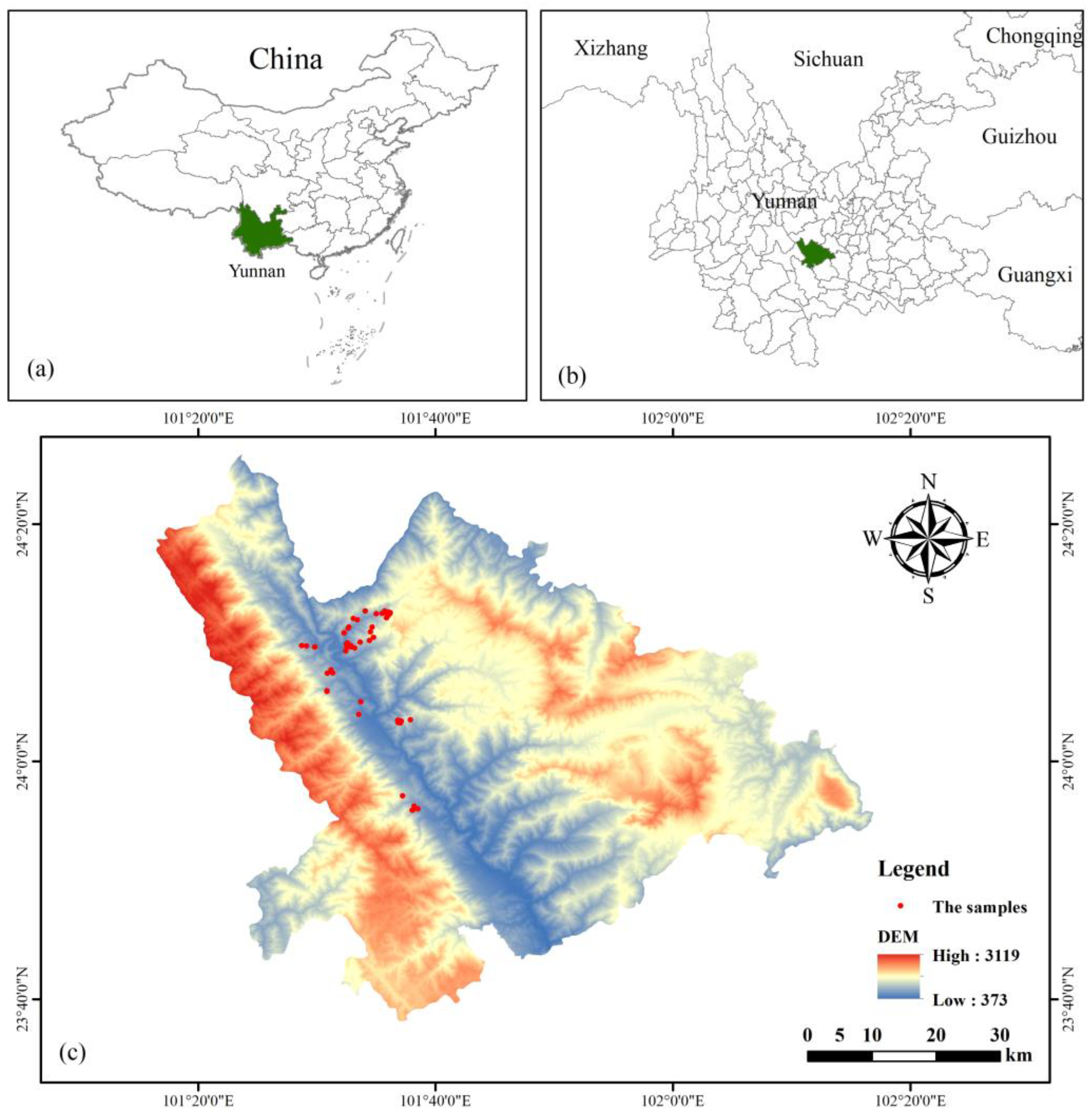
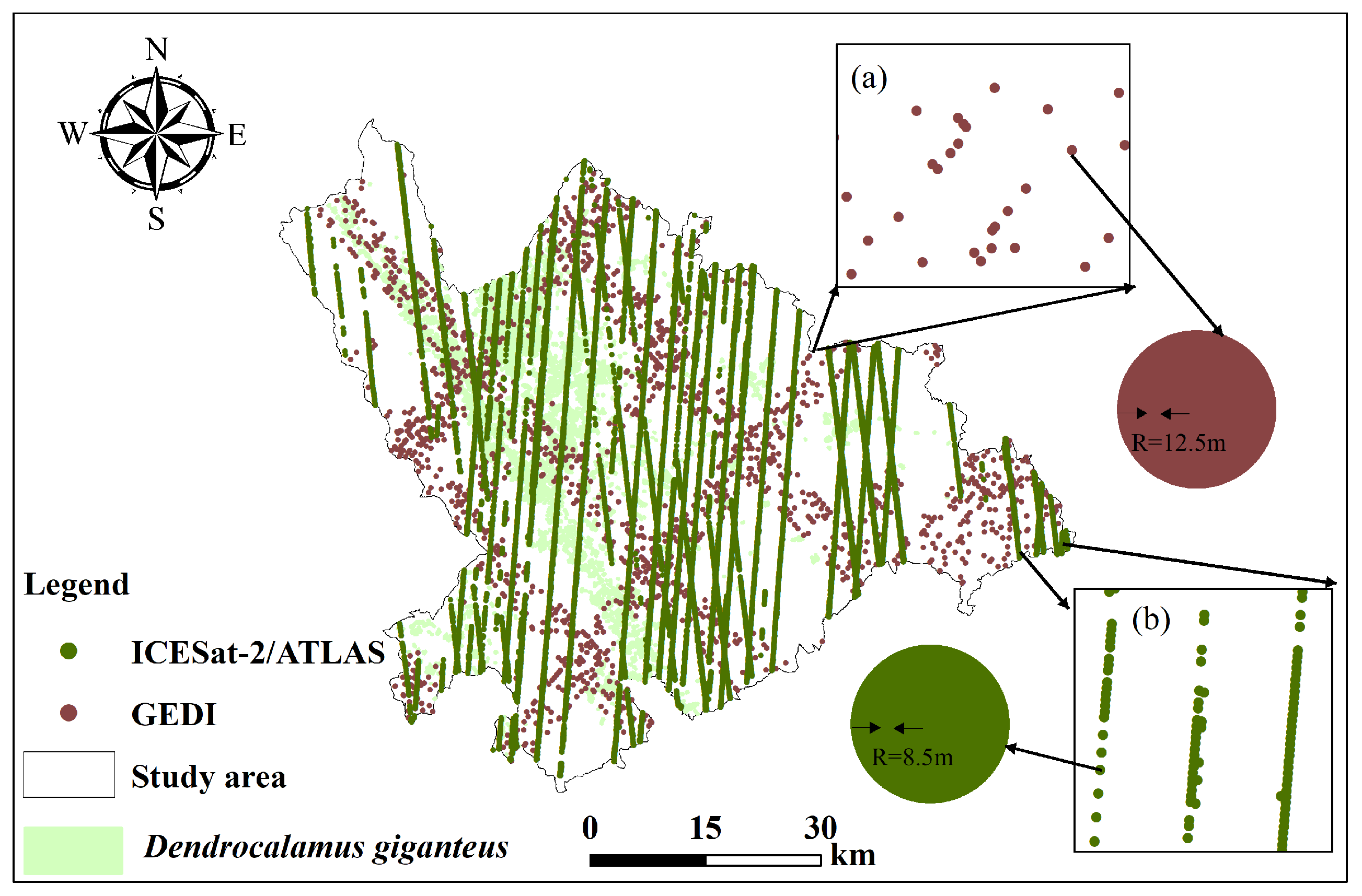
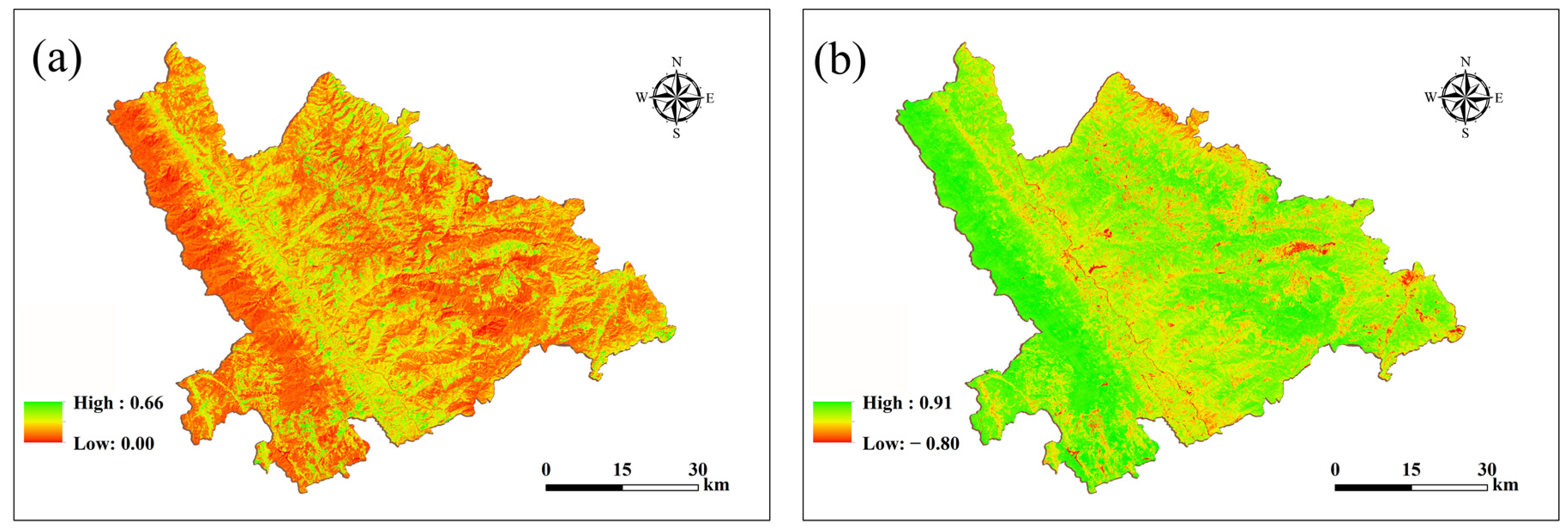
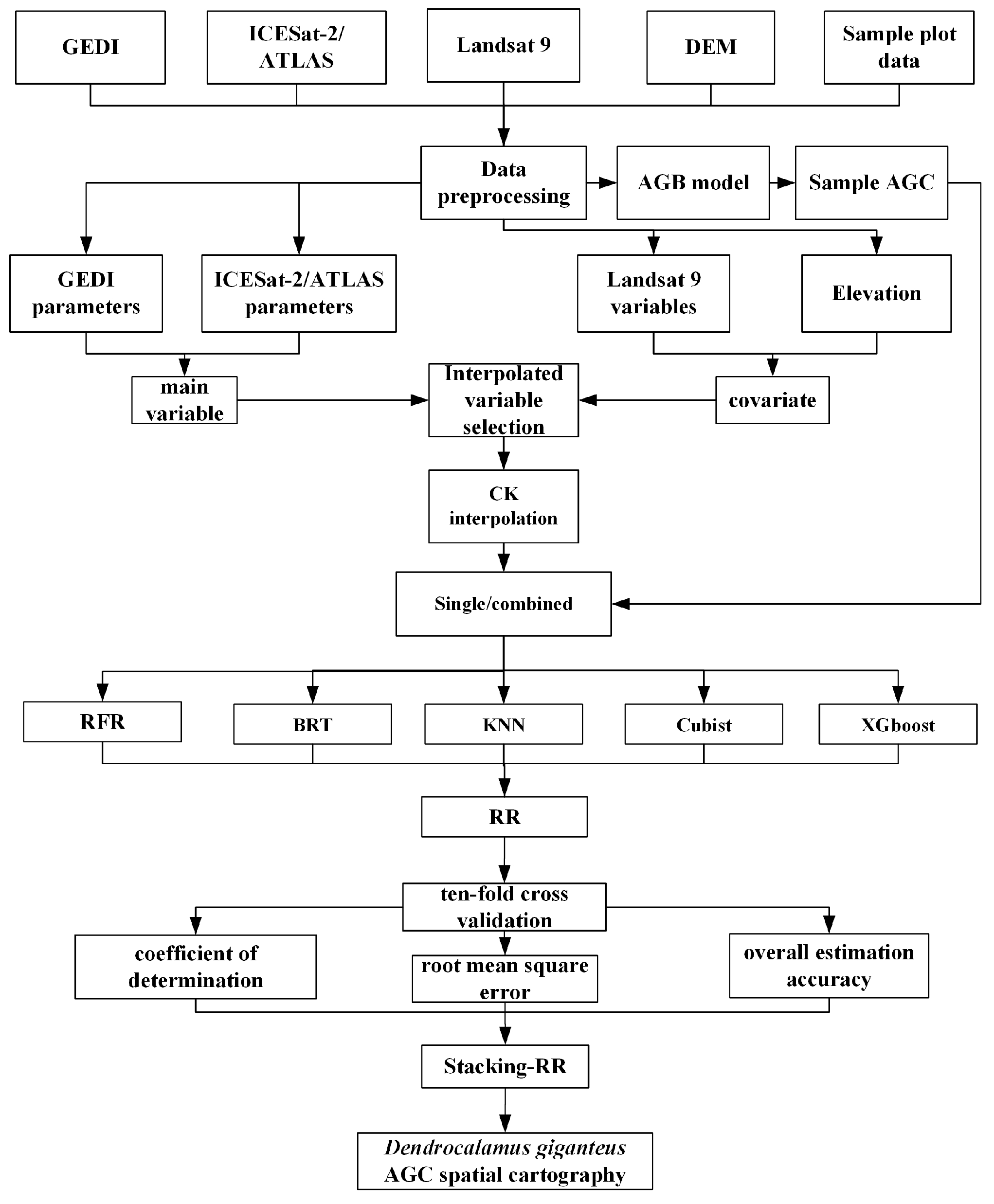
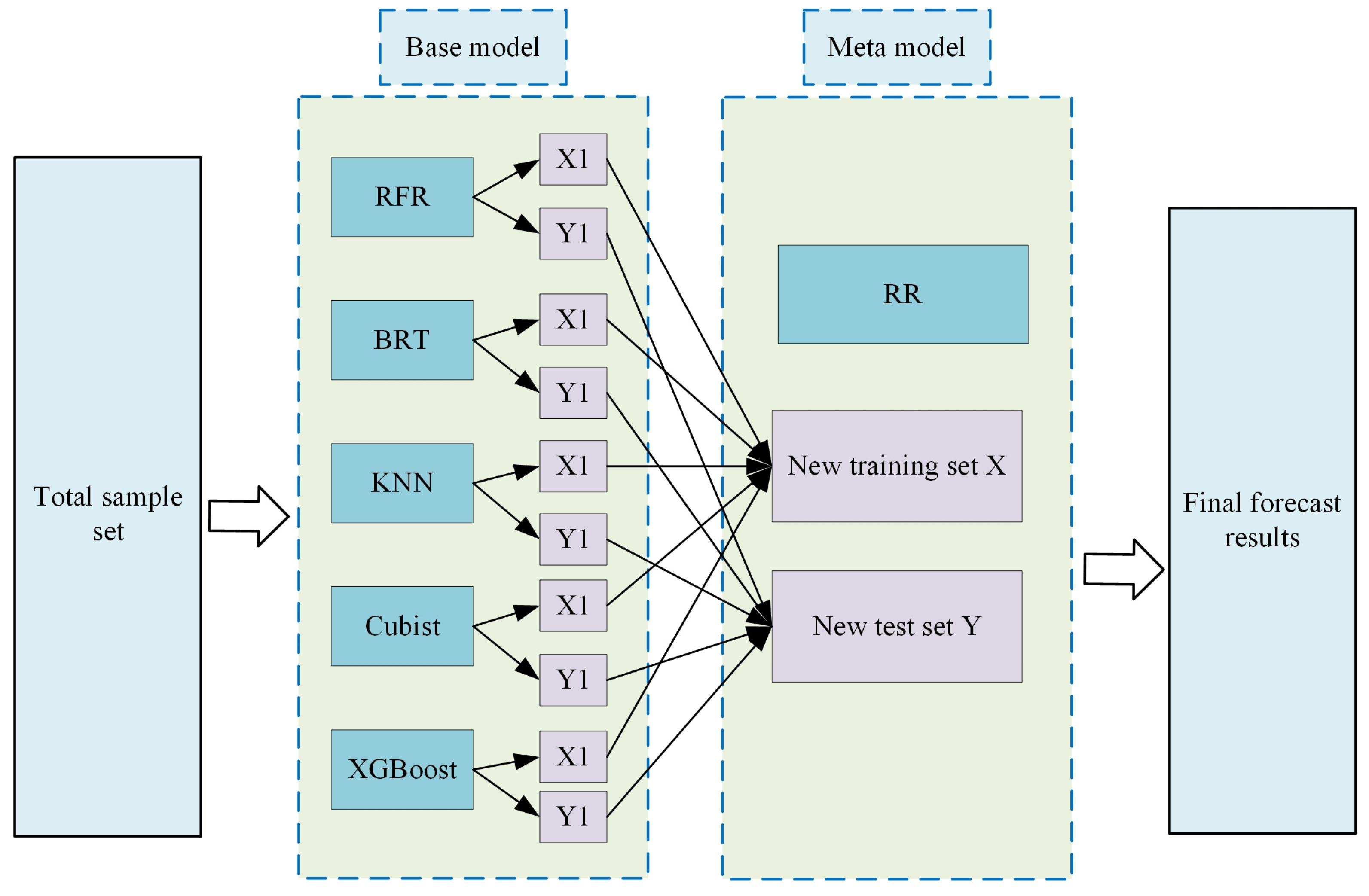
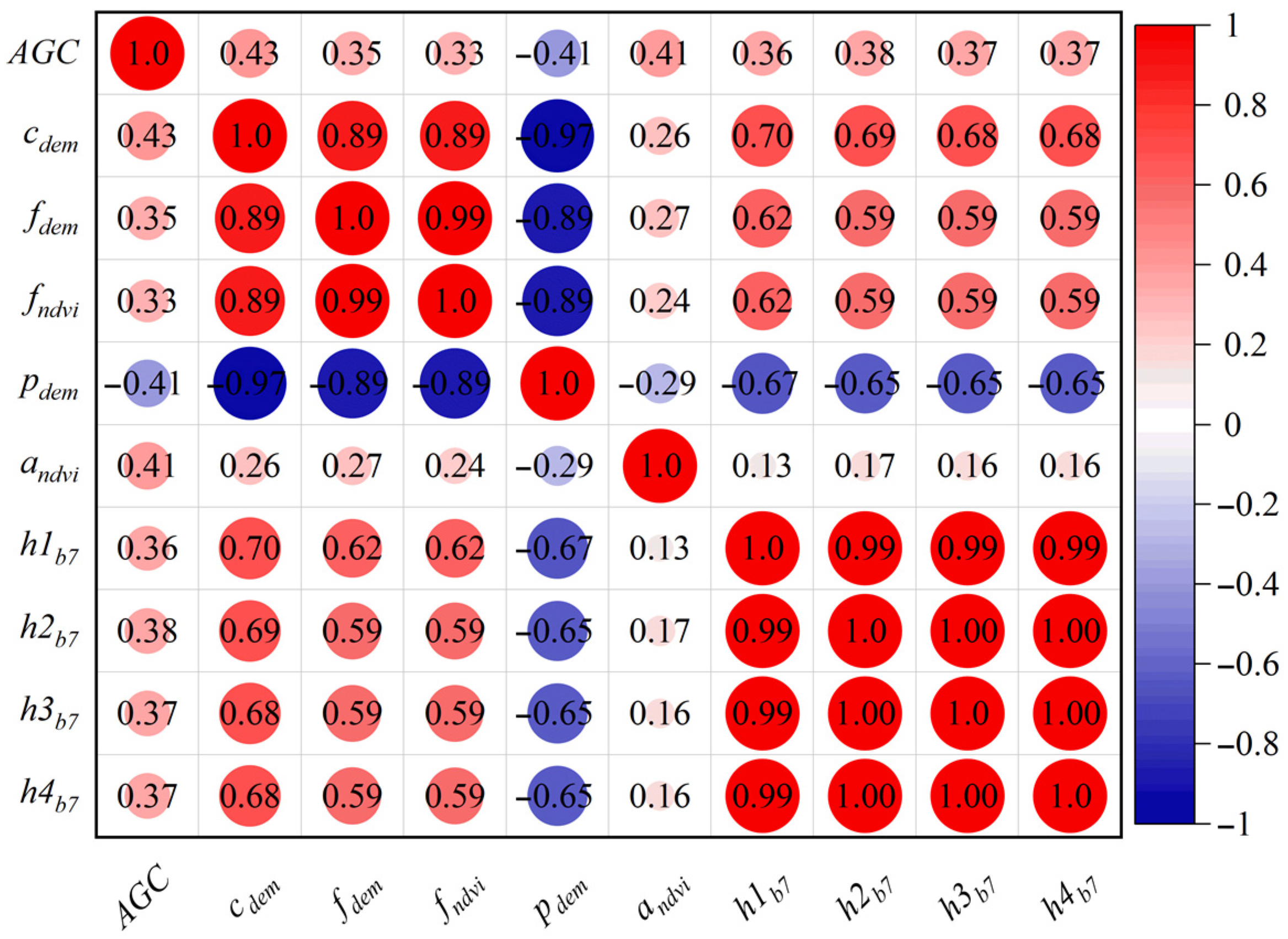
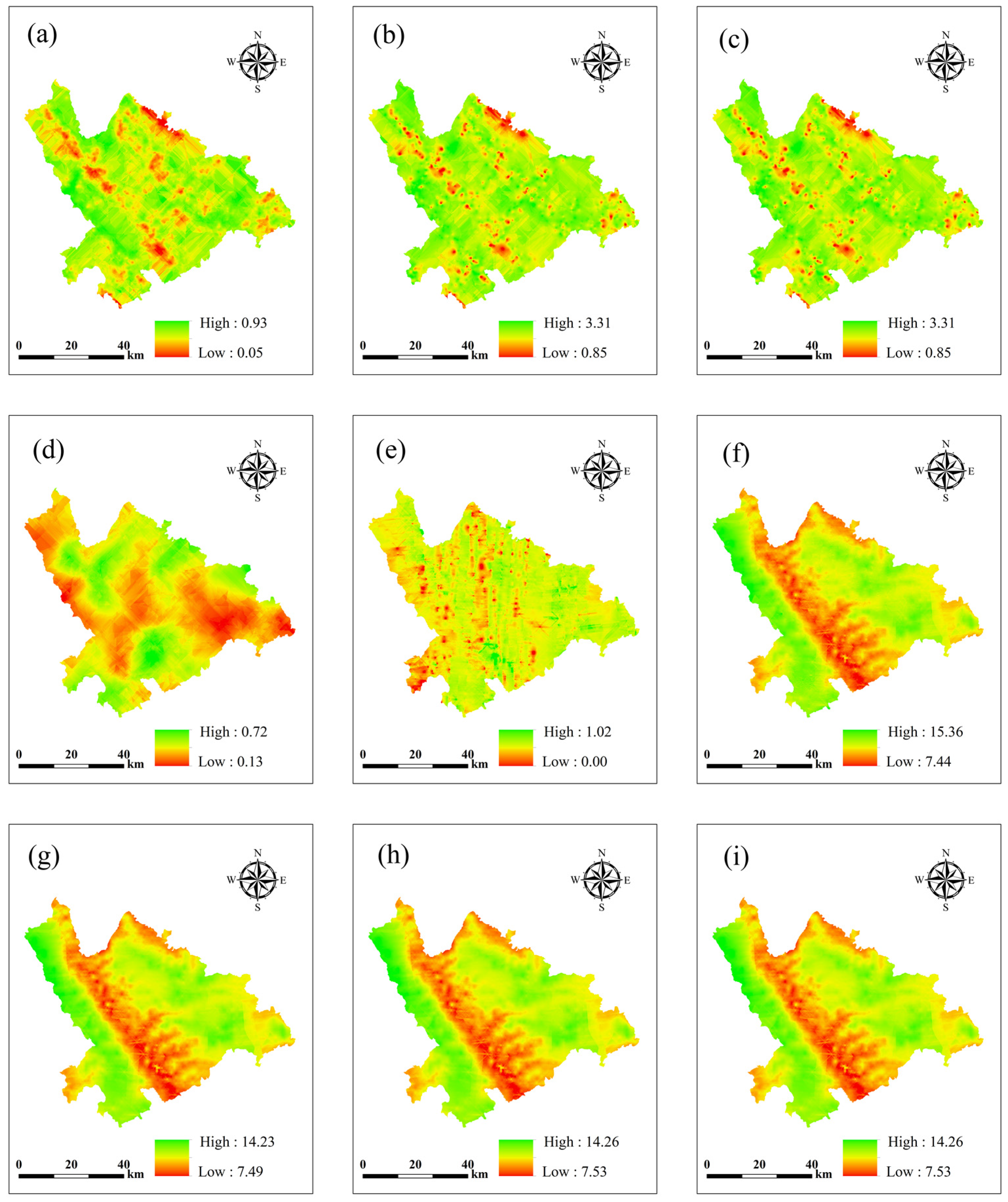

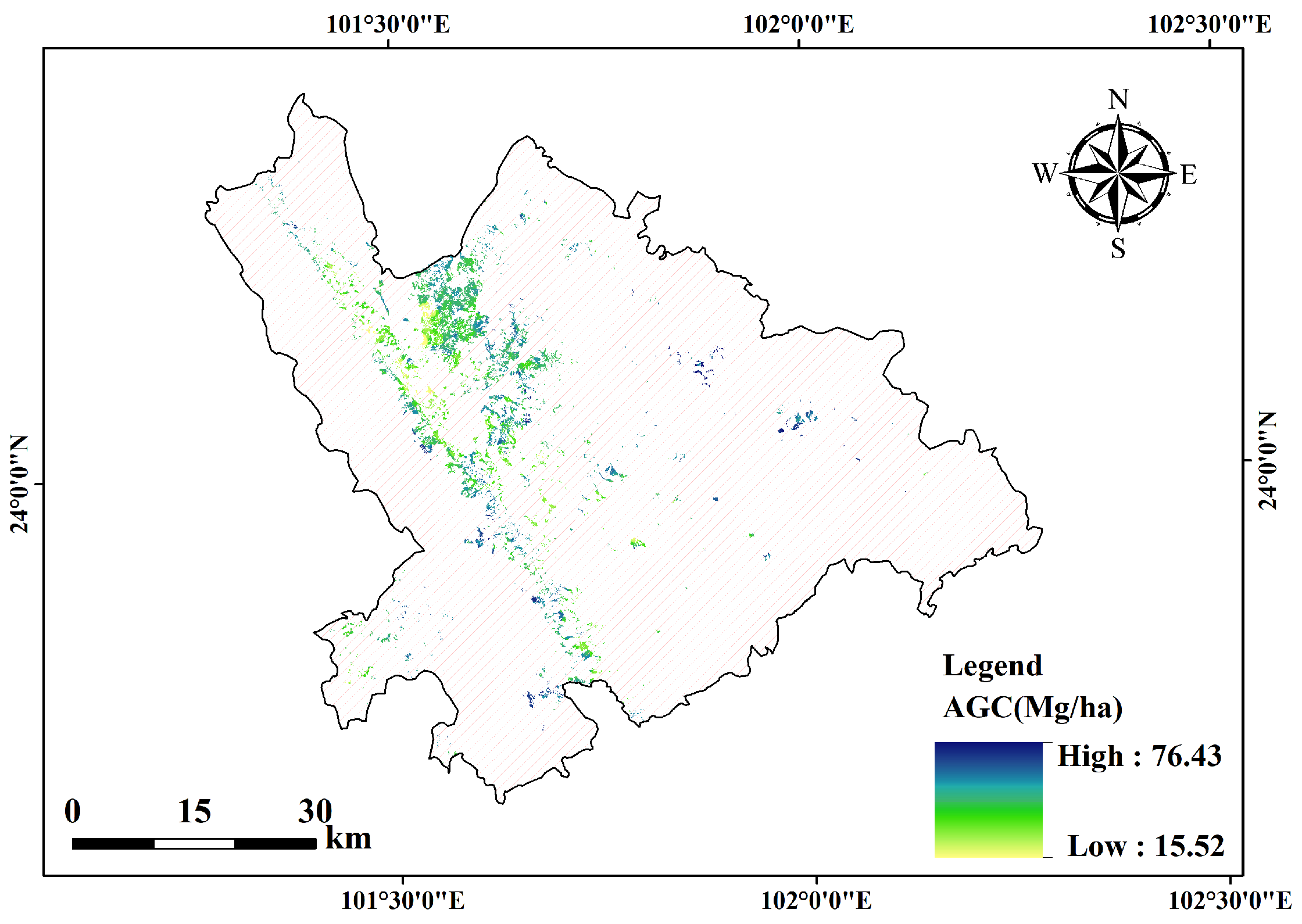
| Sample Size (N) | Minimum (Mg/ha) | Maximum (Mg/ha) | Average (Mg/ha) | SD (Mg/ha) |
|---|---|---|---|---|
| 51 | 4.08 | 101.78 | 41.63 | 20.55 |
| Data Source | Variable Name | Description | Cross Variable | Correlation Coefficient |
|---|---|---|---|---|
| GEDI | c | Total cover, defined as the percentage of the ground covered by the vertical projection of canopy material. | cdem | 0.15 ** |
| f | The foliage height diversity index is calculated by the vertical foliage profile normalized by the total plant area index. | fdem fndvi | 0.18 ** 0.07 ** | |
| p | Estimated Pgap(theta) for the selected L2A algorithm. | pdem | −0.15 ** | |
| ICESat-2/ATLAS | a | Apparent surface Reflectance. | andvi | −0.23 ** |
| h1 | The 98% height of all the absolute individual canopy heights referenced above the WGS84 ellipsoid. | h1b7 | −0.31 ** | |
| h2 | The minimum of relative individual canopy heights within the segment. Relative canopy heights have been computed by subtracting the canopy photon height from the estimated terrain surface. | h2b7 | −0.30 ** | |
| h3 | The median of individual absolute canopy heights within the segment referenced above the WGS84 Ellipsoid. | h3b7 | −0.307 ** | |
| h4 | Mean of the individual absolute canopy heights within segment referenced above the WGS84 Ellipsoid. | h4b7 | −0.306 ** | |
| Landsat 9 | b7 | Short-Wave Infrared 2. | ||
| ndvi | Normalized vegetation index. | |||
| ALSO | dem | Elevation. |
| Data Source | Model | Parameter | Value |
|---|---|---|---|
| GEDI | RFR | mtry, ntree | 2, 300 |
| BRT | n.trees, interaction. depth, shrinkage | 10,000, 2, 0.01 | |
| KNN | k-neighbors | 2 | |
| Cubist | Committees, neighbor | 6, 4 | |
| XGBoost | Nrounds, max_depth, eta | 50, 2, 0.1 | |
| RR | lambda | 0.1 | |
| ICESat-2/ATLAS | RFR | mtry, ntree | 2, 300 |
| BRT | n.trees, interaction. depth, shrinkage | 10,000, 10, 0.01 | |
| KNN | k-neighbors | 2 | |
| Cubist | Committees, neighbors | 6, 4 | |
| XGBoost | Nrounds, max_depth, eta | 50, 3, 0.1 | |
| RR | lambda | 0.1 | |
| GEDI+ICESat-2/ATLAS | RFR | mtry, ntree | 5, 1000 |
| BRT | n.trees, interaction. depth, shrinkage | 10,000, 4, 0.01 | |
| KNN | k-neighbors | 2 | |
| Cubist | Committees, neighbor | 6, 6 | |
| XGBoost | Nrounds, max_depth, eta | 80, 2, 0.1 | |
| RR | lambda | 0.01 |
| Information Source | Modeling Factor | model | C0 | C0 + C | SR/% | a/m | RSS | R2 |
|---|---|---|---|---|---|---|---|---|
| Cross-variable (cdem) | Gaussian | 0.1 | 53.71 | 0.19 | 12,817.18 | 715 | 0.82 | |
| GEDI + DEM | Spherical | 0.1 | 53.52 | 0.19 | 16,100 | 777 | 0.81 | |
| Exponential | 0.1 | 53.87 | 0.19 | 18,900 | 1226 | 0.71 | ||
| Cross-variable (fdem) | Gaussian | 0.1 | 93.09 | 0.11 | 12,817.18 | 2298 | 0.81 | |
| GEDI + DEM | Spherical | 0.1 | 92.70 | 0.11 | 16,100 | 2503 | 0.80 | |
| Exponential | 0.1 | 93.19 | 0.11 | 18,600 | 3933 | 0.70 | ||
| Cross-variable (fndvi) | Gaussian | 1.33 × 10−2 | 0.19 | 7.05 | 20,264.99 | 9.31 × 10−3 | 0.83 | |
| GEDI + Landsat 9 | Spherical | 1.00 × 10−4 | 0.19 | 0.05 | 24,500 | 1.01 × 10−2 | 0.81 | |
| Exponential | 1.00 × 10−4 | 0.20 | 0.05 | 32,100 | 1.38 × 10−2 | 0.76 | ||
| Cross-variable (pdem) | Gaussian | −0.1 | −54.87 | 0.18 | 12,817.18 | 681 | 0.83 | |
| GEDI + DEM | Spherical | −0.1 | −54.67 | 0.18 | 16,100 | 743 | 0.82 | |
| Exponential | −0.1 | −55.05 | 0.18 | 18,900 | 1205 | 0.73 | ||
| Cross-variable (andvi) | Gaussian | −0.01 | −30.65 | 0.03 | 14,722.43 | 308 | 0.81 | |
| ICESat−2/ATLAS + Landsat 9 | Spherical | −0.01 | −30.46 | 0.03 | 18,200 | 342 | 0.79 | |
| Exponential | −0.01 | −30.6 | 0.03 | 21,000 | 529 | 0.70 | ||
| Cross-variable (h1b7) | Gaussian | −7.70 × 10−3 | −3.97 × 10−2 | 19.40 | 19,745.38 | 4.16 × 10−5 | 0.97 | |
| ICESat−2/ATLAS + Landsat 9 | Spherical | −4.00 × 10−3 | −3.98 × 10−2 | 10.05 | 24,500 | 3.26 × 10−5 | 0.98 | |
| Exponential | −1.00 × 10−4 | −4.07 × 10−2 | 0.25 | 27,900 | 6.49 × 10−5 | 0.96 | ||
| Cross-variable (h2b7) | Gaussian | −7.40 × 10−3 | −3.94 × 10−2 | 18.78 | 19,918.58 | 4.04 × 10−5 | 0.97 | |
| ICESat−2/ATLAS + Landsat 9 | Spherical | −3.00 × 10−3 | −3.95 × 10−2 | 7.59 | 24,400 | 3.21 × 10−5 | 0.98 | |
| Exponential | −1.00 × 10−4 | −4.06 × 10−2 | 0.25 | 28,800 | 6.67 × 10−5 | 0.97 | ||
| Cross-variable (h3b7) | Gaussian | −8.09 × 10−3 | −3.97 × 10−2 | 20.39 | 24,100 | 4.00 × 10−5 | 0.97 | |
| ICE−Sat−2/ATLAS + Landsat 9 | Spherical | −3.00 × 10−3 | −3.97 × 10−2 | 7.56 | 24,100 | 3.26 × 10−5 | 0.98 | |
| Exponential | −1.00 × 10−4 | −4.07 × 10−2 | 0.25 | 28,200 | 6.52 × 10−5 | 0.96 | ||
| Cross-variable (h4b7) | Gaussian | −7.80 × 10−3 | −3.96 × 10−2 | 19.70 | 19,918.58 | 4.04 × 10−5 | 0.97 | |
| ICESat−2/ATLAS + Landsat 9 | Spherical | −2.90 × 10−3 | −3.97 × 10−2 | 7.30 | 24,100 | 3.27 × 10−5 | 0.98 | |
| Exponential | −1.00 × 10−4 | −4.07 × 10−2 | 0.25 | 28,200 | 6.53 × 10−5 | 0.96 |
| Modeling Factor | ME | RMSE | MSE | RMSSE | ASE |
|---|---|---|---|---|---|
| cdem | 0.00 | 0.31 | 0.00 | 0.97 | 0.32 |
| fdem | 0.00 | 0.53 | 0.00 | 0.97 | 0.54 |
| fndvi | 0.00 | 0.53 | 0.00 | 1.00 | 0.52 |
| pdem | 0.00 | 0.31 | 0.00 | 0.97 | 0.32 |
| andvi | 0.00 | 0.07 | −0.01 | 0.85 | 0.08 |
| h1b7 | 0.00 | 0.31 | 0.00 | 1.16 | 0.26 |
| h2b7 | 0.00 | 0.31 | 0.00 | 1.15 | 0.26 |
| h3b7 | 0.00 | 0.31 | 0.00 | 1.16 | 0.26 |
| h4b7 | 0.00 | 0.30 | 0.00 | 1.06 | 0.29 |
Disclaimer/Publisher’s Note: The statements, opinions and data contained in all publications are solely those of the individual author(s) and contributor(s) and not of MDPI and/or the editor(s). MDPI and/or the editor(s) disclaim responsibility for any injury to people or property resulting from any ideas, methods, instructions or products referred to in the content. |
© 2024 by the authors. Licensee MDPI, Basel, Switzerland. This article is an open access article distributed under the terms and conditions of the Creative Commons Attribution (CC BY) license (https://creativecommons.org/licenses/by/4.0/).
Share and Cite
Yang, H.; Qin, Z.; Shu, Q.; Xi, L.; Xia, C.; Wu, Z.; Wang, M.; Duan, D. Estimation of the Aboveground Carbon Storage of Dendrocalamus giganteus Based on Spaceborne Lidar Co-Kriging. Forests 2024, 15, 1440. https://doi.org/10.3390/f15081440
Yang H, Qin Z, Shu Q, Xi L, Xia C, Wu Z, Wang M, Duan D. Estimation of the Aboveground Carbon Storage of Dendrocalamus giganteus Based on Spaceborne Lidar Co-Kriging. Forests. 2024; 15(8):1440. https://doi.org/10.3390/f15081440
Chicago/Turabian StyleYang, Huanfen, Zhen Qin, Qingtai Shu, Lei Xi, Cuifen Xia, Zaikun Wu, Mingxing Wang, and Dandan Duan. 2024. "Estimation of the Aboveground Carbon Storage of Dendrocalamus giganteus Based on Spaceborne Lidar Co-Kriging" Forests 15, no. 8: 1440. https://doi.org/10.3390/f15081440
APA StyleYang, H., Qin, Z., Shu, Q., Xi, L., Xia, C., Wu, Z., Wang, M., & Duan, D. (2024). Estimation of the Aboveground Carbon Storage of Dendrocalamus giganteus Based on Spaceborne Lidar Co-Kriging. Forests, 15(8), 1440. https://doi.org/10.3390/f15081440






